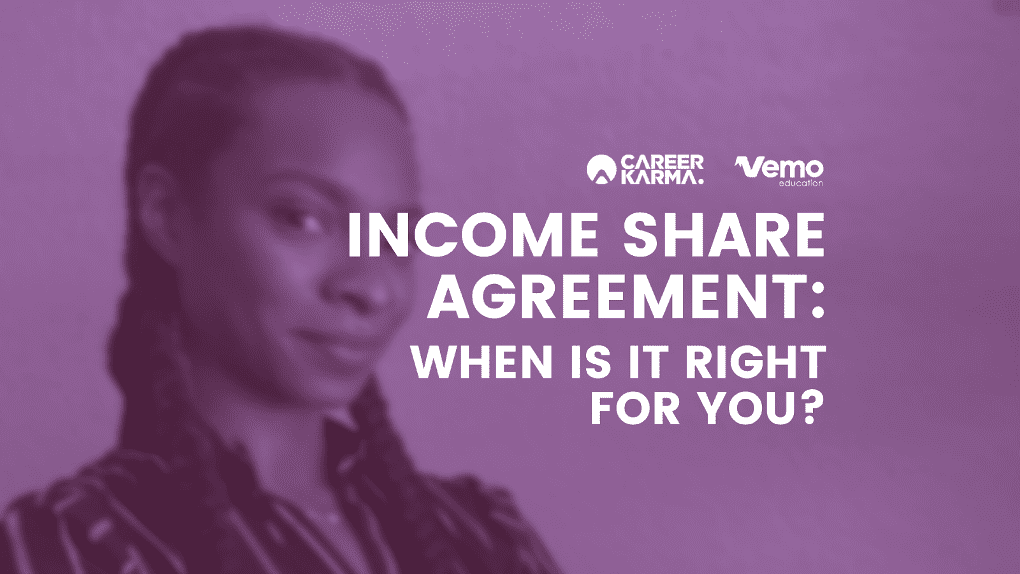For six years, Caitlin Golden worked as a mobile expert for one of the largest wireless carriers in the United States. Then one day, she decided to change networks.
“It was toxic,” Caitlin said. She knew it was a risk to walk away from her job, but she also knew she had to make a change. Caitlin chose to pursue a career in full stack software engineering, which she saw as a gateway to professional growth and a good work-life balance.
To make the switch, she had to learn new skills. To learn new skills, she had to pay for training—in Caitlin’s case, from coding bootcamp Kenzie Academy. This created a dilemma. Now out of a job, Caitlin couldn’t afford to pay out of pocket. And she did not want to take out a traditional student loan.
“That’s why I never went to college,” said Caitlin. “It’s because I’ve always gone the opposite direction of student loans.”
Fortunately, Kenzie Academy offered another financing option that appealed to Caitlin more: the income share agreement (ISA). While the ISA is still a loan, the terms of Caitlin’s ISA aligned more with what she needed at the time.
That said, Caitlin is quick to note that every ISA isn’t for everyone. So, how do you evaluate the terms of an ISA and decide when one’s right for you?
What Is an Income Share Agreement?
To determine the right audience for an income share agreement, it’s important to know what the financing option is all about.
Put simply, an income share agreement is a type of loan that commits a school to providing educational services without up-front payment. In exchange, the student agrees to pay their debt via a fixed percentage of future earnings for a fixed period of time.
Vocational and technical schools, such as coding bootcamps, have adopted the model most readily. These education providers cater to learners who haven’t found success with traditional learning models or traditional credit marketplaces.
With an ISA loan, you can get quick skills training to a tech career without assuming traditional student loans, all while knowing your payments will scale with your income.
The Five Key Features of Income Share Agreements
Before we dive deep into the key features of income share agreements, note that Kenzie Academy no longer offers the ISA option to its students. This makes Caitlin one of the last Kenzie students to benefit from the financing option.
That said, ISAs—no matter the school or provider—are typically built out of similar features.
1. Salary Floor
The premise of the ISA is that the school cannot take a cut unless and until you have secured a job that pays more than a specified income threshold. In Caitlin’s case, her ISA payments will kick in once she lands a job that pays a gross income of at least $3,333.33 per month (or $40,000 per year).
Payments adjust in real time, so that you’ll only pay your obligation when you’re in the financial position to do so. Consider the following scenarios:
- When you land a job that pays above the monthly threshold, your ISA payments start.
- If your monthly earnings drop below the threshold at any time within the payment window, your ISA payments are paused. They will only resume if and when your income hits the threshold again.
- In the unlikely event that you earn less than the minimum income threshold or fail to get a job and your earnings remain static throughout the duration of your payment window, your ISA obligation will be fulfilled and you won’t have paid anything.
2. Income Share Percentage
Once you hit the minimum income threshold, you must pay a fixed percentage of your earnings to the school. For Caitlin, that means paying 13 percent of her future gross monthly income to the school.
“That’s a little nerve-wracking for me because it’s like you’re getting taxed two times,” she said, “But when I weigh that against how much I will be making in the field, I considered that pennies…The end goal has always been larger than what it’s going to take to get there.”
3. Payment Term
Unlike traditional student loans, ISA loans typically cannot snowball into decades of financial obligation. Career Karma’s Income Share Agreement Report reveals that coding bootcamps generally limit ISA payments from nine to 36 monthly payments, although some may last longer.
Kenzie Academy’s full ISA loan is considered complete once you’ve paid 48 monthly payments or hit the payment cap in an eight-year payment window, a far cry from the average student loan repayment length of 18.5 years.
To paint a clearer picture, once Caitlin has paid 48 monthly payments that are worth 13 percent of her gross monthly income to the school, her ISA obligation ends.
4. Payment Ceiling
To ensure that the total payback remains reasonable, ISAs typically come with a payment ceiling, often called a “payment cap.” For some, this might be 1.2 to two times the amount fronted by the school. Your ISA obligation ends if you satisfy the conditions listed above or you hit the payment ceiling.
5. Job Placement Services
Because schools that offer ISAs typically have more financial stake in ensuring their students succeed, they often provide job placement services. These services are designed to optimize students’ job search experience, thereby increasing their chances of landing a well-paying job.
Why an ISA: Caitlin Golden’s Story

When Caitlin walked away from her job, she knew she had to get herself back in the game immediately and recoup her losses. “One of the very first coding schools I came across was Kenzie Academy,” said Caitlin.
“I did a lot of research, and I found out that it had a partnership with a university. That was very appealing to me because—I’m not gonna lie—I was really skeptical about a bootcamp,” she said. “Another one of my biggest concerns was that the Full Stack Software Engineering Program cost $20,000, and that is huge,” admitted Caitlin.
“That’s why I really appreciated the flexible payment options Kenzie offered and was particularly drawn to the ISA. With the ISA, the school was willing to take a risk and educate me essentially for free for one year before it ever saw a penny or a return on its investment. That was the turning point for me.”
“I thought that if the school can educate me without pay for now and only require payment once I get a job that makes over a certain threshold, that sounds like the school and I are both taking an equal risk,” said Caitlin. “It just made me more comfortable to set aside that time to better myself.”
Caitlin’s line of thought echoed the vision of income share agreements, which is to align incentives between the school and the student. With the school’s profit tied to the student’s success, both parties essentially work toward the same goal: to train the student sufficiently so they land a well-paying job in the industry.
At the moment, Caitlin is in her last quarter of the program and is scheduled to finish the program in late July. “I actually ended up repeating a quarter because I didn’t manage my time well. I thought I could work full time, but it turned out to be really taxing that I just fell behind in that quarter,” shared Caitlin, grateful that the school allowed her to retake the quarter.
“I realized that if you demonstrate your passion early on, the school will fight for you. I think that’s the reason why the school handled me the way they did. They knew that I had a certain level of potential and that I could learn from other people while pulling others up.”
When Is an Income Share Agreement Right For You?
Despite the appeal of ISAs, the truth is that every ISA isn’t right for everyone. Some of the most important considerations lie in the unique program terms—such as the income share, payment cap, minimum income threshold, and maximum number of monthly payments—as well as the alternative financing options you have.
Beyond those considerations, for Caitlin, the secret lies in the three Cs: your current circumstance, commitment level, and career clarity.
1. Circumstance
“Taking an ISA is a personal decision. You should weigh it with your values and circumstances. I am fortunate enough to have a spouse who supports my decision 100 percent. He works full time while I finish my training. So, I think that’s a really important point to consider,” said Caitlin.
An ISA might also be the right fit for learners who cannot afford to pay tuition up front and have less attractive financing alternatives. With an ISA, you get the chance to learn without having to pay up front in exchange for making future income-based payments.
“I think it’s so important to note that if you don’t have the lump sum up front and there’s not a feasible and practical way for you to pay monthly, the ISA takes all that worry off the table,” said Caitlin.
“You have the time to put that extra effort into training and landing a job and making sure that once the ISA payments kick in, it’s not going to choke you out.”
2. Commitment
For an ISA to be worth it, both the student and the school should work equally hard to make the former job-ready. “If you commit to an ISA, you must be willing to push yourself incredibly hard,” said Caitlin.
“A bootcamp is named that for a reason. It is tough. So, if you can internalize that, push yourself, and commit to the course, then you know that you’ll [likely] stand to make a certain range in the future.”
3. Career Clarity
At the end of the day, an ISA is a loan, and a financial commitment that should not be taken lightly. “If you’re not certain with your path, don’t commit to an ISA,” said Caitlin. “You’re basically locking yourself into payments that you’re not even sure you’re willing to take on.”
”Weighing all three factors, Caitlin expressed confidence in her choice of taking the ISA route. “When I also consider how much support I receive from the school—which is basically round the clock—and the confidence that I now have in my skill set, I think getting into Kenzie and taking an ISA are worth it.”
Is she worried about the ISA payments?
“Not at all,” said Caitlin.
“I’ve solidified a network such that I know I’ll be okay. I knew that I had to put in the work before the finish line comes so that I’m not caught off guard. I needed to set the stage for post-curriculum. That way, I’m not shooting myself in the foot, and I have an idea of where I’ll land in terms of a job,” said Caitlin.
“I can show up and execute. I’m confident.”
A Strong Contender
So far, Caitlin has earned her Front End Software Engineering Certification and is only weeks away from earning her Backend Software Engineering Certification. After completing her training, Caitlin will be starting her job search with the help of Kenzie Academy’s Career Placement Team.
“I’m kind of nervous about it,” admitted Caitlin, “because it’ll require putting yourself out there, which is always anxiety-inducing. But this is all welcome. I know that this anxiety builds up right before you break into the next level in your journey or your life, in general,” said Caitlin.
“Right now, I’m at an exciting part of my life.”
About us: Career Karma is a platform designed to help job seekers find, research, and connect with job training programs to advance their careers. Learn about the CK publication.




